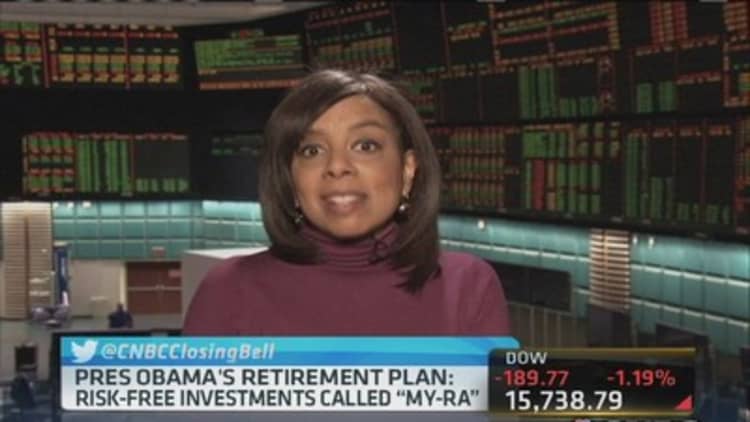Many mutual fund companies and brokerage firms, including T. Rowe Price and Vanguard Group, require a minimum deposit of between $1,000 and $3,000 to open a traditional IRA or Roth retirement savings account, presenting a barrier to entry for would-be savers who can sock money away monthly but can't scrape together the initial deposit to open an account.
That's why President Obama proposed the myRA. It's billed as the Roth IRA for every man—a risk-free retirement plan for those of modest means, workers with no access to a 401(k) and those with neither the comfort level nor lump-sum deposit to open an IRA on their own.
But is there any reason for a saver to stay in a myRA beyond the $1,000 mark, especially with so many IRA offerings on the market, some of which waive the IRA minimum for savers who agree to automatic investment programs?
(Read more: CNBC Explains: The myRA)
One of the main criticisms of the myRA is that an account earns the same rate as the federal employees' Thrift Savings Plan G Fund—the Government Securities Investment Fund—which produced average annual returns of 1.89 percent for the 12 months ending December 2013, 3.4 percent over the last decade, and 5.5 percent since April 1987.
Taking risk—i.e., investing in the stock market—earlier in a career and at a younger age is considered the most important step for savers to have a decent chance at amassing a retirement nest egg. So overcoming the traditional IRA $1,000 minimum may not be just one of the reasons for low-income workers to invest in a myRA—it may be the only reason.
While myRA accounts would have a maximum account balance of $15,000, some financial advisors say that for most savers, getting out at $1,000—the level at which they qualify for a private Roth IRA—may be the wise financial step.
Above and beyond $1,000
"MyRA is not for everyone," said Vielka Burey-Jacas, a certified financial planner with Women's Financial Advisory Group in Miami. "One of the major cons to myRA, is that there are not many choices. Account holders do not have to pay fees, and their principal is protected, but you can only invest in bonds."
With a starting balance of $1,000 and monthly contributions of $50, for example, your account would grow to $19,054 after 20 years, assuming a 3.4 percent rate of return—equivalent to the 10-year return for the government savings bonds that the myRA will mirror.
That same investor would have amassed $31,275 by investing in a more aggressive stock portfolio through a regular Roth that returned an average 7.5 percent—the average annual return for the Dow Jones Industrial Average since 1900, according to the Stock Trader's Almanac.
(Read more: A financial advisor who really doesn't like the myRA)
Those who lack the minimum initial deposit to open a private Roth could contribute to a myRA until they reach the $1,000 threshold and then transfer the funds to a brokerage account, said Burey-Jacas. Alternatives do exist in the form of low-cost Roths available from private brokerage firms, which enable investors to better diversify.

Low-cost alternatives to the myRA
At Fidelity Investments, there's no minimum required to open a traditional IRA or Roth at Fidelity Investments. Investment of the assets in an IRA are subject to mutual fund minimums, but those minimums can be waived by enrolling in the automatic account-builder program with contributions of at least $200 per month.
Many discount brokers offer low-fee IRAs:
—Charles Schwab waives the $1,000 minimum for clients who agree to automatic monthly deposits of $100. There are no other fees associated with their IRAs.
—ShareBuilder charges no fees on Roths or traditional IRAs, and they waive the $25 custodial fee, too. There are no restrictions on the type of investments customers can select, including exchange-traded funds (ETFs), mutual funds, stocks or fixed-income (bond) ETFs. There is no fee for cash contributions, but the company charges its regular commission of $4 for automatic investments and $6.95 for real-time trades.
—Scottrade similarly has no setup, annual or maintenance fees—they even pay new clients up to $1,000 when they roll over an old 401(k) or IRA.
—Firstrade offers no-fee Roths and traditional IRAs, with no account service fees or minimum balance requirements.
—E-Trade's Roth also comes with no annual fees and no account minimums.
While fee-free IRA programs generally apply to both Roths and traditional IRAs, low-income savers should invest exclusively in Roths, since the tax deduction for traditional IRA contributions yields little benefit for those in the lowest tax brackets, said Ed Slott, an IRA expert with irahelp.com and author of "The Retirement Savings Time Bomb and How to Diffuse It."
Roths, of course, are funded with after-tax dollars, offering no immediate tax deduction, but the money in the account grows tax-free.
Traditional IRAs are the exact opposite. Pretax contributions can help lower your annual tax bill, but the earnings are taxed as ordinary income upon retirement.
"Why take a deduction that's essentially worthless when you could put that same investment into a Roth, where it will grow tax-free," Slott said. "The last thing you want in retirement is to have a tax bill. The Roth is the way to go."
Buyer beware
Ted Beck, president and chief executive of the National Endowment for Financial Education, said investors should be aware that they can potentially lose money by opting to invest in equities, or stocks, through a private Roth IRA instead of opening a myRA. They may also get hit with a host of fees, including annual service fees, transaction fees and costs associated with closing the account.
Research in retirement savings shows that IRA fees are a big issue and on average are higher than 401(k) fees. Some of those fees, however, can be mitigated by selecting a no-cost or low-cost private Roth, particularly one that does not require a minimum initial deposit.
The issue of a lack of investment savvy, though, could pose just as great a risk for myRA account holders if they wait until they reach the $15,000 account maximum—in fact, they would just have much larger account balances to hand over to fee-gauging financial firms.
"A lot of people don't know what to do or where to start, so this is a very simple, costless way to get people to save without having to worry about losing their money or whether they're investing in the right thing," Slott said. "It's like training wheels."
Training wheels are meant to come off and—in the case of the myRA—maybe sooner rather than later.
—By Shelly K. Schwartz, Special to CNBC.com




